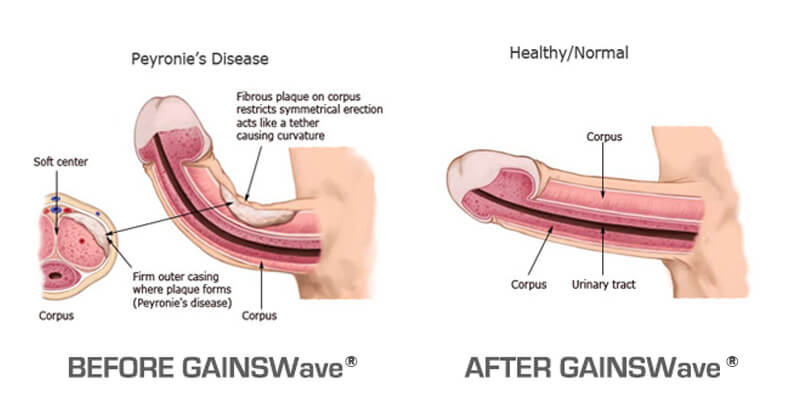Peyronie’s Disease Treatment
Men are often reluctant to discuss their sexual health out of embarrassment, fear of judgement, or simply because they don’t understand what’s happening. Ignoring these issues, however, can have long-term consequences like erectile dysfunction, emotional distress and anxiety, and can even cause irreparable damage to intimate relationships. Which is why it is understandable that experts believe that roughly 9 percent of men suffer from some form of Peyronie’s disease.
What Is Peyronie’s Disease?
Peyronie’s disease is characterized by a fibrous scar tissue that forms beneath the surface of the penis that can alter its appearance and function. If left untreated, this scar tissue, which can be mild or acute, can make it problematic for otherwise healthy men to have normal erections by creating a painful curvature of the penis which can make having sex difficult or impossible. Although the symptoms can sometimes relieve themselves, often a male who is given this diagnosis should speak with their doctor to determine what options may be available to him to have it treated.
Our Peyronie’s Disease Treatment Services

Signs and Symptoms of Peyronie’s Disease
Although penises, like fingerprints, are all different and can even have a natural curve to them, men who experience pain when erect or during sex should speak to their doctor about the possibility that these problems stem from Peyronie’s disease.
The symptoms that men with Peyronie’s disease may notice can develop quickly or slowly over time. Regardless of the speed at which Peyronie’s disease symptoms develop, the most common include:
- Scar Tissue Build-Up: A man may notice hard lumps or bands of tissue under the skin of his penis.
- Significant Penis Bend: A major symptom of Peyronie’s is penile curvature in any direction, defined by an unnatural and severe curve or bend, with or without an erection.
- Misshapen Penis: Occasionally, this disease can cause portions of the erect penis to narrow, often resembling an hourglass in shape.
- Penis Shortening: Some men note that the length of their penis is reduced when Peyronie’s is present.
- Penis Pain: Peyronie’s can cause a man to experience penile pain whether he has an erection or not.
- Erectile Dysfunction: Otherwise healthy men with Peyronie’s may experience problems getting or maintaining an erection.
Peyronie’s Disease Causes:
Unfortunately, the exact Peyronie’s disease cause is still unknown , however, it frequently accompanies physical trauma. When a normal penis becomes aroused, blood rushes in and fills its chambers causing it to become erect. The elastic tissue alongside these chambers acts as a protective sheath and allows for a full erection. When the sheath becomes damaged due to trauma, hard scar tissue called plaque – essentially a buildup of collagen – forms and causes inelasticity. Without the required flexibility, the penis creates a curvature, or bend. Generally, Peyronie’s disease causes are brought about by things like:
Acute Injury:
If a man hits his penis very hard, or bends it because of an accident, it can cause an acute injury. Likewise, vigorous sexual activity, and bending of the penis during penetration, or by his partner’s pubic bone, are also common causes. He may or may not realize he’s hurt himself immediately as the pain can diminish quickly.
Chronic & Repeated Injury:
Certain athletic activities, such as bicycling or horseback riding for long periods, can cause repeated injury to a man’s penis. Since they involve a great deal of sitting, pressure, and jolts to the groin area, that can cause Peyronie’s to develop over time. As with any acute injury, the man may not realize the damage until symptoms appear.
Prostate Surgery:
In recent years, a growing trend regarding Peyronie’s has been noted for those suffering from prostate cancer. Many urologists now suspect that, at least in some men who have undergone radical prostatectomy, there is reason to believe that complications from this type of surgery can induce Peyronie’s as the patient recovers from the procedure.
Autoimmune Disorders:
Some experts believe that autoimmune diseases that affect connective tissues may lead to Peyronie’s disease. If the immune system attacks cells inside the penis, it can lead to inflammation, scarring, and severe curvature.
Family History:
Men who have close relatives with Peyronie’s disease may also be at risk for developing it themselves. Although an uncomfortable topic to bring up, understanding your family’s health and history can help both you and your doctor manage the disease more easily.
Age:
Sexual performance naturally declines as a man ages with changes in hormonal levels and elasticity of penile tissue. The inclination towards Peyronie’s also increases, affecting men who are over the age of 55, more often than their younger counterparts. If he smokes, consumes alcohol, ingests certain drugs, has had prostate surgery, or other health issues are present, a man’s risk is even greater as he ages.
A Natural Solution to Peyronie’s Disease with GAINSWave
Fortunately, if you’re searching for a more natural, non-invasive treatment for Peyronie’s disease, GAINSWave can help. Peyronie’s disease is treatable, and most men are able to return to optimal sexual performance after therapy.
This treatment uses a premium brand of high frequency low-intensity shockwaves, or soundwaves, to break down scar tissue (plaque) and open blood vessels and create new ones. This increases blood flow, reduces the curvature of the penis, and corrects any potential erectile dysfunction.
GAINSWave is one of the only drug-free, surgery-free therapeutic options for men with Peyronie’s disease that has proven its effectiveness in clinical trials.
Alternative Peyronie’s Disease Treatment Options
If you are experiencing pain or have noticed a curvature of your penis, it is important to seek care from a healthcare provider, especially if it prevents you from having intercourse or impairs your ability to maintain healthy, intimate relationships. Your healthcare provider will begin by reviewing your medical and family history in addition to a physical exam in which he or she will examine your penis for signs of plaque. If a physical exam fails to produce evidence of plaque, or your healthcare provider would like to pinpoint the exact location of the plaque buildup, imaging tests such as an X-ray or ultrasound may be required. Common recommendations for Peyronie’s disease treatments could include:
Making Lifestyle Changes:
Some studies suggest that Peyronie’s disease could be made worse if men have certain habits, including smoking, drug use, and alcohol consumption. Cutting back on these things or eliminating them entirely – along with exercising more and eating right – could not only return you to better health overall, it may also help with the condition.
Prescription Drug Treatment:
Medication focuses on reducing plaque to curtail overall pain and discomfort thereby improving the men’s health. While very expensive, collagenase is the only FDA-approved medicine for Peyronie’s disease and is injected into the scar tissue to help break it down. While clinical trials prove that these injections can help to reduce the curve, this treatment of Peyronie’s can cause significant side effects including penile fractures, allergic reactions, bleeding, swelling, itching, erection problems, and painful sex.
One of the most popular prescription medicines for treating Peyronie’s is Verapimil, which is typically prescribed for treating high blood pressure and angina. This medicine was originally intended to be used to prevent strokes, heart attacks and various kidney problems, but was also shown to have some benefit for men suffering from Peyronie’s disease. Within the body, Verapimil works by relaxing the blood vessels throughout the body to improve the overall flow of blood. Unfortunately, as with many other such prescription medicines, it can have adverse side effects for some users including hypotension, increased liver enzyme production, and a host of nuisance conditions like frequent constipation, dizziness, headaches, indigestion, nausea, rashes, edema, and even swollen gums.
Another popular prescription option is Xiaflex. Originally designed to treat Dupuytren’s Contracture, this medicine works by dissolving some of the plaque deposits that can build up in the extremities. Although this medicine has been proven to be effective at reducing the symptoms in some patients, many of the side effects are enough to give some men pause when considering it as a treatment for Peyronie’s. Some of the known side effects include corporal rupture, tendon and ligament damage, nerve damage, and it can even elevate the risk of excessive bleeding.
Exercises to Treat Peyronie’s:
For some, the distressing symptoms of Peyronie’s disease can be mitigated with exercise of the affected area. Often prescribed to patients as the first step or in tandem with injectable treatments such as Xiaflex, this program can often be a painful endeavor as it requires forceful manipulation of the penis. For those who choose exercise to lessen the effects of Peyronie’s, it often becomes a tedious affair requiring a fairly strict regimen of exercises lasting five to six weeks after the injection. As this treatment protocol typically consists of eight treatments administered every five to six weeks, the entire process can take up to a year to complete.
Surgery:
Surgery is recommended only in long-term Peyronie’s disease cases in which the curvature of the penis is acute and has been unresponsive to non-invasive treatments. The most common surgeries include a penile implant to help sustain an erection and straighten the penis, grafting to cover openings in the tunica albuginea once scar tissue is removed, and plication in which a surgeon pinches or removes a piece of tunica albuginea on the opposite side of the plaque to help straighten the penis. These surgeries have risks including shortening, numbness, or you could lose your erectile function entirely.
Vacuum Devices:
These devices attempt to stretch and bend the penis to regain a normal shape through mechanical traction. It requires daily use, over the course of several months, through the use of an at-home, inflatable vacuum cylinder. While they can provide small improvements to penis curvature, they are unable to provide significant improvements in men with moderate to severe penis curvature, and men who experience erectile dysfunction in addition to Peyronie’s disease.
Your Sexual Enhancement Starts Here
Make an appointment with us by filling out the form below
Or call — 941 241 8888
“I used to have very painful erections and my penis had a sharp unnatural curve to it. I found Prime Medical Solutions of Sarasota and went in for a consultation. They diagnosed me with Peyronie’s Disease and I immediately began the Acoustic Wave Therapy treatment. After a number of sessions, my penis is back to normal and I no longer have painful erections.”
Lando N.
Satisfied Patient
Your Sexual Enhancement is Our Mission
Contact Us today to start enhancing your sexual performance
